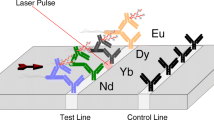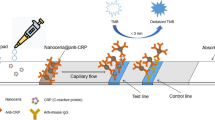Abstract
Lactoferrin (LF) is an important multifunctional protein that comprises a large fraction of the protein mass in certain human fluids and tissues, and its concentration is often used to assess health and disease. LF can be nitrated by multiple routes, leading to changes in protein structure, and nitrated proteins can negatively impact physiological health via nitrosative stress. Despite an awareness of the detrimental effects of nitrated proteins and the importance of LF within the body, cost-effective methods for detecting and quantifying nitrated lactoferrin (NLF) are lacking. We developed a procedure to selectively quantify NLF using sandwich enzyme-linked immunosorbent assay (ELISA), utilizing a polyclonal anti-LF capture antibody paired with a monoclonal anti-nitrotyrosine detector antibody. The assay was applied to quantify NLF in samples of pure LF nitrated via two separate reactions at molar ratios of excess nitrating agent to the total number of tyrosine residues between 10/1 and 100/1. Tetranitromethane (TNM) was used as a laboratory surrogate for an environmental pathway selective for production of 3-nitrotyrosine, and sodium peroxynitrite (ONOO−) was used as a surrogate for an endogenous nitration pathway. UV-vis spectroscopy (increased absorbance at 350 nm) and fluorescence spectroscopy (emission decreased by > 96%) for each reaction indicate the production of NLF. A lower limit of NLF detection using the ELISA method introduced here was calculated to be 0.065 μg mL−1, which will enable the detection of human-physiologically relevant concentrations of NLF. Our approach provides a relatively inexpensive and practical way to assess NLF in a variety of systems.

We developed a procedure to selectively quantify nitrated lactoferrin (NLF) protein using a sandwich enzyme-linked immunosorbent assay (ELISA) and verified results against several spectroscopic techniques. Our approach provides an inexpensive and practical way to assess NLF in a variety of systems.







Similar content being viewed by others
References
Kanyshkova TG, Buneva VN, Nevinsky GA. Lactoferrin and its biological functions. Biochem Mosc. 2001;66(1):1–7.
Vorland LH. Lactoferrin: a multifunctional glycoprotein. APMIS. 1999;107(7–12):971–81.
Kijlstra A, Jeurissen SH, Koning KM. Lactoferrin levels in normal human tears. Br J Ophthalmol. 1983;67(3):199–202.
Jenssen H, Hancock REW. Antimicrobial properties of lactoferrin. Biochimie. 2009;91(1):19–29.
Lönnerdal B, Iyer S. Lactoferrin: molecular structure and biological function. Annu Rev Nutr. 1995;15(1):93–110.
González-Chávez SA, Arévalo-Gallegos S, Rascón-Cruz Q. Lactoferrin: structure, function and applications. Int J Antimicrob Agents. 2009;33(4):301–e1.
Valko M, Leibfritz D, Moncol J, Cronin MTD, Mazur M, Telser J. Free radicals and antioxidants in normal physiological functions and human disease. Int J Biochem Cell Biol. 2007;39(1):44–84.
Yeo W-S, Lee S-J, Lee J-R, Kim K-P. Nitrosative protein tyrosine modifications: biochemistry and functional significance. BMB Rep. 2008;41(3):194–203.
Gow AJ, Duran D, Malcolm S, Ischiropoulos H. Effects of peroxynitrite-induced protein modifications on tyrosine phosphorylation and degradation. FEBS Lett. 1996;385(1–2):63–6.
Pfeiffer S, Lass A, Schmidt K, Mayer B. Protein tyrosine nitration in cytokine-activated murine macrophages involvement of a peroxidase/nitrite pathway rather than peroxynitrite. J Biol Chem. 2001;276(36):34051–8.
Dalle-Donne I, Scaloni A, Giustarini D, Cavarra E, Tell G, Lungarella G, et al. Proteins as biomarkers of oxidative/nitrosative stress in diseases: the contribution of redox proteomics. Mass Spectrom Rev. 2005;24(1):55–99.
Beckman JS. Oxidative damage and tyrosine nitration from peroxynitrite. Chem Res Toxicol. 1996;9(5):836–44.
Radi R. Protein tyrosine nitration: biochemical mechanisms and structural basis of its functional effects. Acc Chem Res. 2013;46(2):550–9.
Wiseman H, Halliwell B. Damage to DNA by reactive oxygen and nitrogen species: role in inflammatory disease and progression to cancer. Biochem J. 1996;313(Pt 1):17-29.
Reinmuth-Selzle K, Kampf CJ, Lucas K, Lang-Yona N, Fröhlich-Nowoisky J, Shiraiwa M, et al. Air pollution and climate change effects on allergies in the anthropocene: abundance, interaction, and modification of allergens and adjuvants. Environ Sci Technol. 2017;51(8):4119–41.
Lakey PSJ, Berkemeier T, Tong H, Arangio AM, Lucas K, Pöschl U, et al. Chemical exposure-response relationship between air pollutants and reactive oxygen species in the human respiratory tract. Sci Rep. 2016;6:32916.
Patel RP, McAndrew J, Sellak H, White CR, Jo H, Freeman BA, et al. Biological aspects of reactive nitrogen species. Biochim Biophys Acta Bioenerg. 1999;1411(2–3):385–400.
Franze T, Weller MG, Niessner R, Pöschl U. Protein nitration by polluted air. Environ Sci Technol. 2005;39(6):1673–8.
Franze T, Weller MG, Niessner R, Pöschl U. Enzyme immunoassays for the investigation of protein nitration by air pollutants. Analyst. 2003;128(7):824–31.
Reinmuth-Selzle K, Ackaert C, Kampf CJ, Samonig M, Shiraiwa M, Kofler S, et al. Nitration of the birch pollen allergen Bet v 1.0101: efficiency and site-selectivity of liquid and gaseous nitrating agents. J Proteome Res. 2014;13(3):1570–7.
Kampf CJ, Liu F, Reinmuth-Selzle K, Berkemeier T, Meusel H, Shiraiwa M, et al. Protein cross-linking and oligomerization through dityrosine formation upon exposure to ozone. Environ Sci Technol. 2015;49(18):10859–66.
Shuker DE, Prevost V, Friesen MD, Lin D, Ohshima H, Bartsch H. Urinary markers for measuring exposure to endogenous and exogenous alkylating agents and precursors. Environ Health Perspect. 1993;99:33–7.
Sokolovsky M, Riordan JF, Vallee BL. Tetranitromethane. A reagent for the nitration of tyrosyl residues in proteins. Biochemistry. 1966;5(11):3582–9.
Crow JP, Beckman JS. Quantitation of protein tyrosine, 3-nitrotyrosine, and 3-aminotyrosine utilizing HPLC and intrinsic ultraviolet absorbance. Methods. 1995;7(1):116–20.
Engvall E. [28] Enzyme immunoassay ELISA and EMIT. Methods Enzymol. 1980;70:419–39.
Jamshad K, Brennan MD, Bradley N, Beirong GAO, Bruckdorfer R, Jacobs M. 3-Nitrotyrosine in the proteins of human plasma determined by an ELISA method. Biochem J. 1998;330(2):795–801.
Teuwissen B, Masson PL, Osinski P, Heremans JF. Metal-combining properties of human lactoferrin. FEBS J. 1973;35(2):366–71.
Selzle K, Ackaert C, Kampf CJ, Kunert AT, Duschl A, Oostingh GJ, et al. Determination of nitration degrees for the birch pollen allergen Bet v 1. Anal Bioanal Chem. 2013;405(27):8945–9.
Vincent JP, Lazdunski M, Delaage M. On the use of tetranitromethane as a nitration reagent. The reaction of phenol side-chains in bovine and porcine trypsinogens and trypsins. FEBS J. 1970;12(2):250–7.
Rajasekariah GH, Kay GE, Russell NV, Smithyman AM. Assessment of assay sensitivity and precision in a malaria antibody ELISA. J Immunoassay Immunochem. 2003;24(1):89–112.
Riordan JF, Sokolovsky M, Vallee BL. Tetranitromethane. A reagent for the nitration of tyrosine and tyrosyl residues of proteins1. J Am Chem Soc. 1966;88(17):4104–5.
Sokolovsky M, Fuchs M, Riordan JF. Reaction of tetranitromethane with tryptophan and related compounds. FEBS Lett. 1970;7(2):167–70.
Jankowski JJ, Kieber DJ, Mopper K. Nitrate and nitrite ultraviolet actinometers. Photochem Photobiol. 1999;70(3):319–28.
Ter Steege JCA, Koster-Kamphuis L, van Straaten EA, Forget PP, Buurman WA. Nitrotyrosine in plasma of celiac disease patients as detected by a new sandwich ELISA. Free Radic Biol Med. 1998;25(8):953–63.
Ischiropoulos H, Zhu L, Beckman JS. Peroxynitrite formation from macrophage-derived nitric oxide. Arch Biochem Biophys. 1992;298(2):446–51.
Kronman MJ, Holmes LG. The fluorescence of native, denatured and reduced-denatured proteins. Photochem Photobiol. 1971;14(2):113–34.
Lakowicz JR. Principles of fluorescence spectroscopy: Springer Science & Business Media; 2013.
Pöhlker C, Huffman JA, Pöschl U. Autofluorescence of atmospheric bioaerosols—fluorescent biomolecules and potential interferences. Atmos Meas Tech. 2012;5(1):37–71.
Bläckberg L, Hernell O. Isolation of lactoferrin from human whey by a single chromatographic step. FEBS Lett. 1980;109(2):180–4.
Crow JP, Ischiropoulos H. [17] Detection and quantitation of nitrotyrosine residues in proteins: in vivo marker of peroxynitrite. Methods Enzymol. 1996;269:185–94.
De Filippis V, Frasson R, Fontana A. 3-Nitrotyrosine as a spectroscopic probe for investigating protein protein interactions. Protein Sci. 2006;15(5):976–86.
Meyer A, Betzel C, Pusey M. Latest methods of fluorescence-based protein crystal identification. Acta Cryst. 2015;71(2):121–31.
abcam. Anti-Lactoferrin antibody (ab77548). 2017. Accessed 26 Jun 2017.
Ferrante RJ, Shinobu LA, Schulz JB, Matthews RT, Thomas CE, Kowall NW, et al. Increased 3-nitrotyrosine and oxidative damage in mice with a human copper/zinc superoxide dismutase mutation. Ann Neurol. 1997;42(3):326–34.
Chou SM, Wang HS, Komai K. Colocalization of NOS and SOD1 in neurofilament accumulation within motor neurons of amyotrophic lateral sclerosis: an immunohistochemical study. J Chem Neuroanat. 1996;10(3):249–58.
Aggarwal S, Gross CM, Kumar S, Datar S, Oishi P, Kalkan G, et al. Attenuated vasodilatation in lambs with endogenous and exogenous activation of cGMP signaling: role of protein kinase G nitration. J Cell Physiol. 2011;226(12):3104–13.
Estillore AD, Trueblood JV, Grassian VH. Atmospheric chemistry of bioaerosols: heterogeneous and multiphase reactions with atmospheric oxidants and other trace gases. Chem Sci. 2016;7(11):6604–16.
Ashki N, Chan AM, Qin Y, Wang W, Kiyohara M, Lin L, et al. Peroxynitrite upregulates angiogenic factors VEGF-A, BFGF, and HIF-1α in human corneal limbal epithelial cells. Invest Ophthalmol Vis Sci. 2014;55(3):1637–46.
Acknowledgements
Amani Alhalwani acknowledges scholarship support from King Saud bin Abdulaziz University for Health Sciences (KSAU-HS).
Funding
This study received funding support through a grant from the University of Denver Knoebel Institute for Healthy Aging (KIHA).
Author information
Authors and Affiliations
Corresponding author
Ethics declarations
Conflict of interest
The authors declare that they have no conflict of interest.
Electronic supplementary material
ESM 1
(PDF 250 kb)
Rights and permissions
About this article
Cite this article
Alhalwani, A.Y., Repine, J.E., Knowles, M.K. et al. Development of a sandwich ELISA with potential for selective quantification of human lactoferrin protein nitrated through disease or environmental exposure. Anal Bioanal Chem 410, 1389–1396 (2018). https://doi.org/10.1007/s00216-017-0779-7
Received:
Accepted:
Published:
Issue Date:
DOI: https://doi.org/10.1007/s00216-017-0779-7




